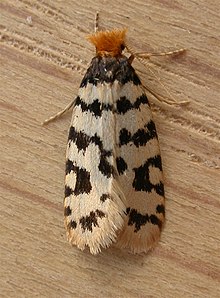Psychidae
| Bagworm moths | |
|---|---|
 |
|
| Adult of an undescribed Iphierga species from Aranda (Australia) |
|
 |
|
| "Bag" of unidentified species | |
| Scientific classification | |
| Kingdom: | Animalia |
| Phylum: | Arthropoda |
| Class: | Insecta |
| Order: | Lepidoptera |
| Division: | Ditrysia |
| Superfamily: | Tineoidea |
| Family: |
Psychidae Boisduval, 1828 |
| Diversity | |
| 10 subfamilies, 241 genera and 1,350 species | |
The Psychidae (bagworm moths, also simply bagworms or bagmoths) are a family of the Lepidoptera (butterflies and moths). The bagworm family is fairly small, with about 1350 species described. Bagworm species are found globally, with some, such as the snailcase bagworm (Apterona helicoidella), settling continents where they are not native in modern times.
Another common name for the Psychidae is "case moths", but this is just as well used for the case-bearers (Colephoridae). The names refer to the habits of caterpillar of these two families, which build small protective cases in which they can hide. The bagworms belong to the superfamily Tineoidea, which is a basal lineage of the Ditrysia just as the Gelechioidea, in which the case-bearers are placed. This means that the bagworms and case-bearers are only as closely related to each other as either is to butterflies (Rhopalocera).
Most bagworms are inoffensive to humans and not at all conspicuous; some are occasional nuisance pests. However, a few species can become more serious pests, and have caused significant damage e.g. to wattle (Acacia mearnsii) in South Africa and orange (Citrus ×sinensis) in Florida. If detected early, picking the cases from the trees while in their pupa stage is an effective way to check an infestation; otherwise, insecticides are used. One bagworm species, the fangalabola (Deborrea malgassa) of Madagascar, is in some places encouraged to breed on wattle trees, because its pupae are collected as a protein-rich food.
...
Wikipedia
